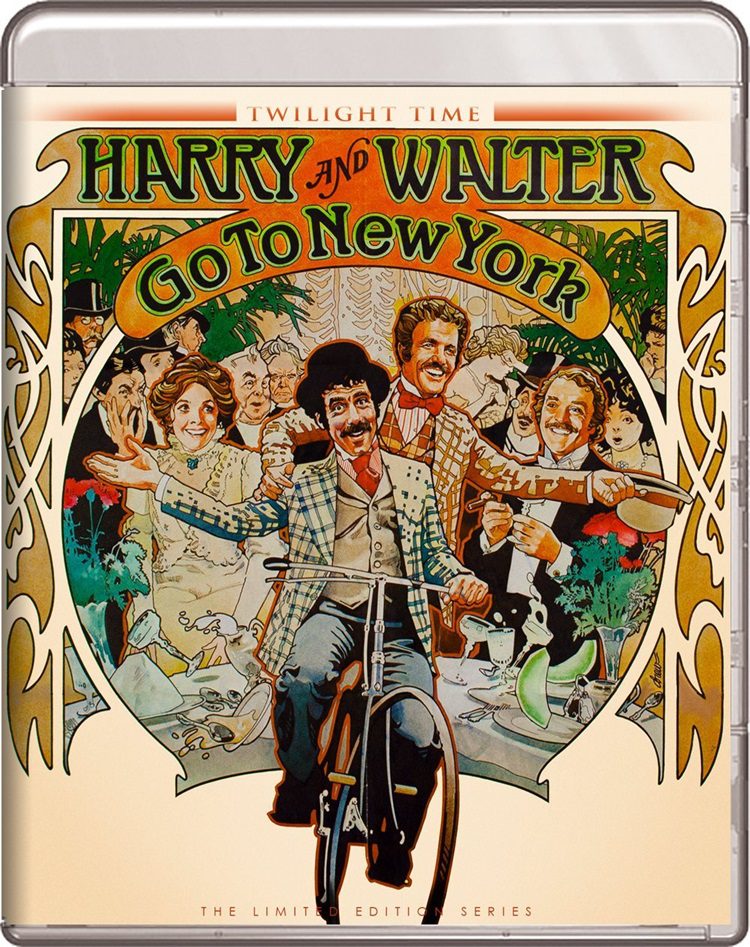
On December 5, 1872, the Mary Celeste was discovered adrift off of the Azores Islands, bereft of its captain and crew, but still loaded with personal possessions and cargo. Not a single soul from the voyage was ever seen or heard from again, and no explanation has ever been discovered behind the mysterious, mass disappearance. But it wasn’t until Columbia Pictures’ Harry and Walter Go to New York debuted in American cinemas nearly 104 years later that those who dared board it had the misfortune of discovering what it was truly like being onboard a ghost ship lost at sea.
Like the Mary Celeste itself, there are many accounts as to how Harry and Walter Go to New York managed to stay afloat for as along as it did without any competent navigation before whatever happened to the movie happened. According to director Mark Rydell (The Cowboys, On Golden Pond), the higher-ups at Columbia Pictures re-edited the film into something (much) less than the laugh-a-minute crime caper comedy it was supposed to be. Another theory professes Rydell pushed the alarm button hisself after drastically re-writing an otherwise good script, thus transforming it into the abandoned mystery it is today.
But either way you theorize how it came to become what it is, there’s no denying Harry and Walter Go to New York is most assuredly something else entirely.
A marginally funny flick about two hapless vaudeville tricksters in the late 1800s, Harry and Walter Go to New York finds James Caan and Elliott Gould as the eponymous duo. Unable to sell their boring stage routine to save their miserable lives, the singing and dancing comedians wander about aimlessly throughout the film ‒ much like the movie itself meanders about mercilessly ‒ until they land in prison along with a suave, sophisticated, high society British bank robber named Adam Worth. Played with all of the gusto and charm such a part requires, the one and only Michael Caine makes the whole feature “Worth” it for his relatively wasted supporting villain role alone.
Enter the great Diane Keaton, who plays a crusading independent reporter named Lissa Chestnut, a character determined to bring Worth down for reasons which are never really given much buoyancy. Alas, the movie is such a mess, even Ms. Keaton can’t do much to save Harry and Walter Go to New York from drifting into the inescapable waters of disaster. The same can be said for the movie’s otherwise amazing supporting cast ‒ a venerable selection of character greats such as Jack Gilford, Charles Durning, Lesley Ann Warren, Burt Young, Dennis Dugan, Carol Kane, Val Avery, Ted Cassidy, Bert Remsen, and George Gaynes ‒ the vast talents of whom are criminally neglected.
Likewise, the main plot here (believe it or not, there really is one) ‒ which finds Harry and Walter attempting to beat Worth to the punch in the robbing of a recently upgraded bank vault ‒ is generally overlooked in lieu of long, awkward, unfunny moments of situational comedy. When Rydell (or whoever it was that approved the final release cut) does choose to focus on the story, (t)he(y) do so sparingly, but they certainly don’t spare us from the agony of one of the dullest caper comedy finales of all time. Even when Harry and Walter Go to New York miraculously manages to conclude with a satisfying payoff (no pun intended), the feeling of abject emptiness remains.
A production which reportedly put the whole of Columbia Pictures into jeopardy when the film went over budget (resulting in a group of German dentists saving the studio, according to legend), Harry and Walter Go to New York has been drifting in and out of ports ever since its disastrous 1976 premiere. Previously released on DVD in 2002 by Columbia TriStar Home Entertainment and re-issued on MOD DVD-R by Sony in 2015, this Limited Edition release from Twilight Time marks the first time the film has hit home video in High-Definition. Harry and Walter Go to New York arrives on Blu-ray via an MPEG-4 AVC 1080p encode and in it’s original 2.35:1 aspect ratio.
Overall, the lighting accomapnying László Kovács’ cinematography here is rather dark. I guess they were going for authenticity, as Harry and Walter Go to New York takes place before electric lights took over, but ‒ much like the various, contrasting stories as to who is responsible for butchering the film itself ‒ there is really no telling. The default DTS-HD MA 2.0 Mono English soundtrack comes through quite nicely, and there are optional English (SDH) subtitles at your disposal. Special features for this “very special” movie include David Shire’s isolated score in DTS-HD MA 2.0, and an audio commentary with film historians Eddy Friedfeld, Lee Pfeiffer, and Paul Scrabo.
Despite the fact that neither of the three professionals point out an uncredited cameo by former Ed Wood bit player Ben Frommer (because that’s the sort of utterly useless information everyone should know, right?), the track makes for a much more enjoyable listen than the actual movie does itself. They also appear to have recorded their comments individually, resulting in some uneven audio, but it isn’t problematic. The original theatrical trailer is also included here, but ultimately, it’s the liner notes from Twilight Time’s own Julie Kirgo which prove to be the lifeboat to safety for anyone who may find themselves stranded aboard Harry and Walter Go to New York.
Recommended for those of you who love a good movie disaster. Or a good unsolved mystery.